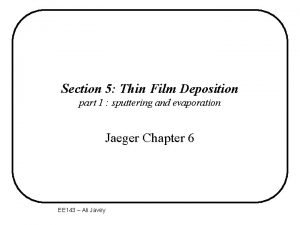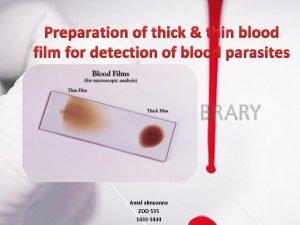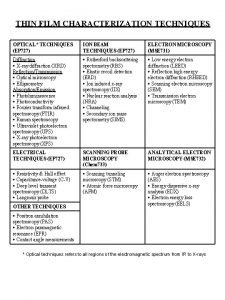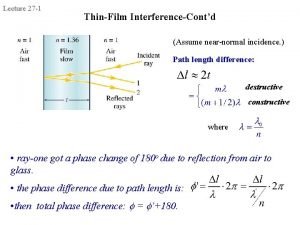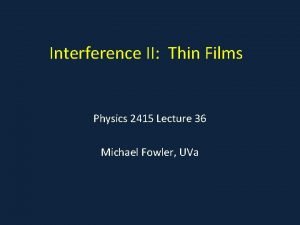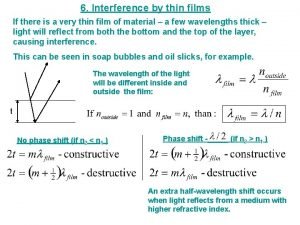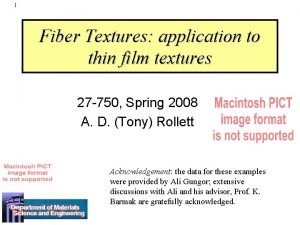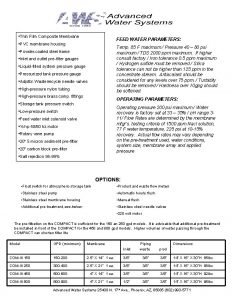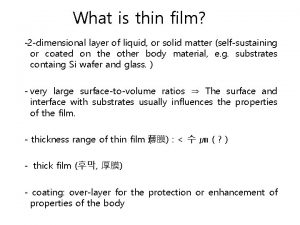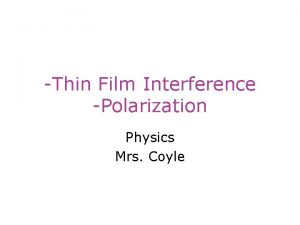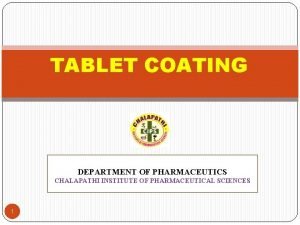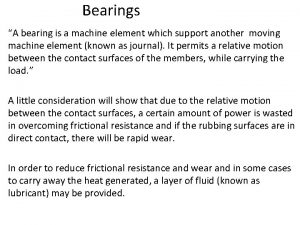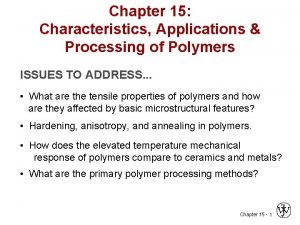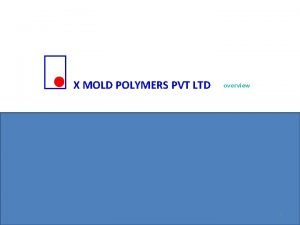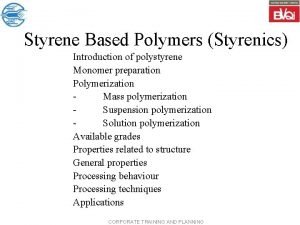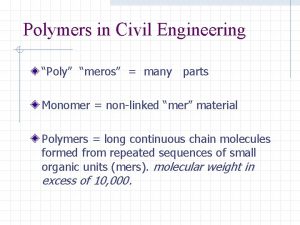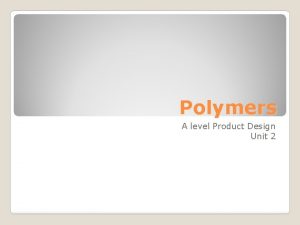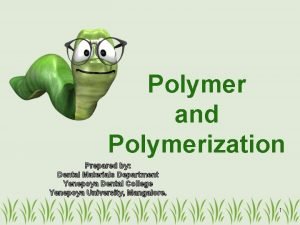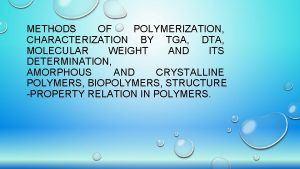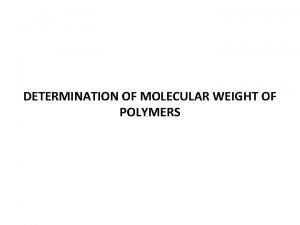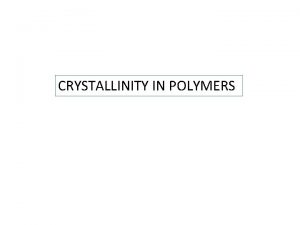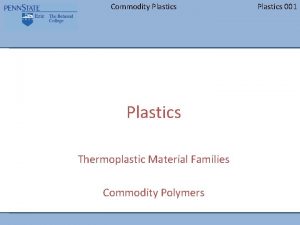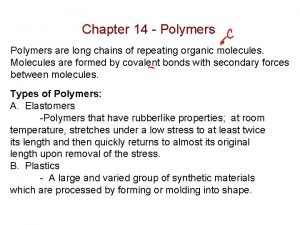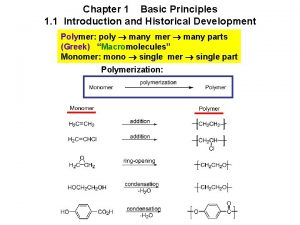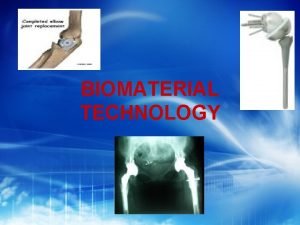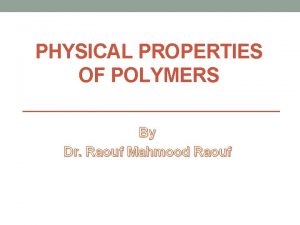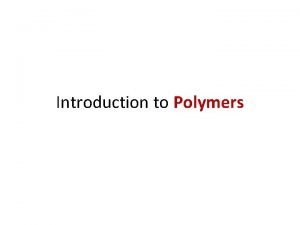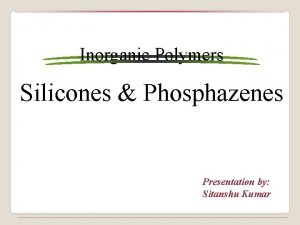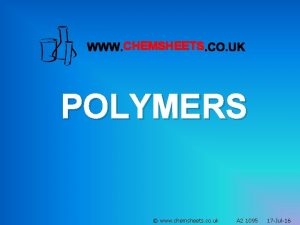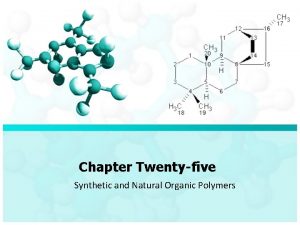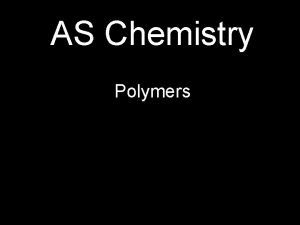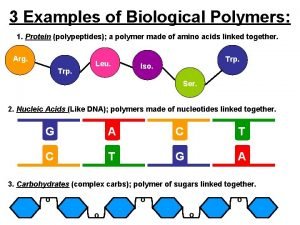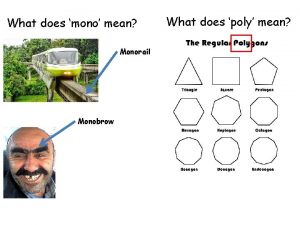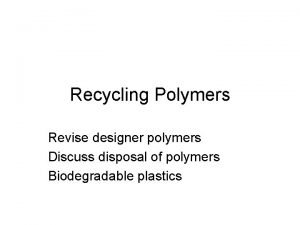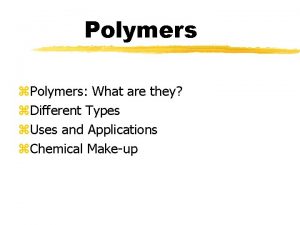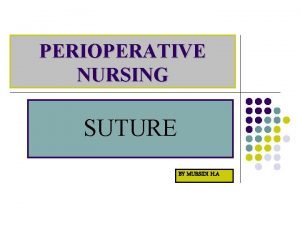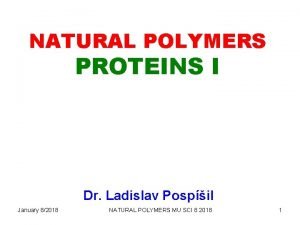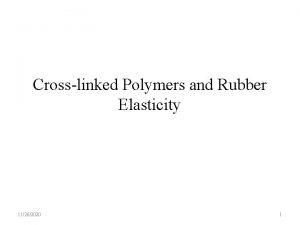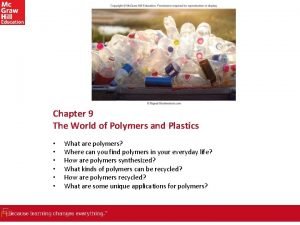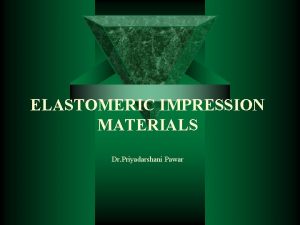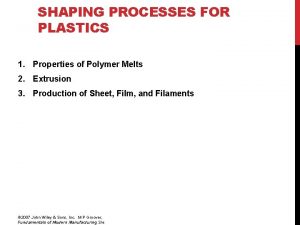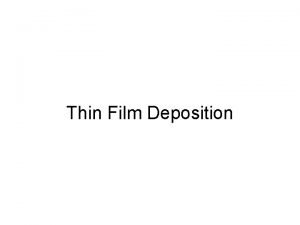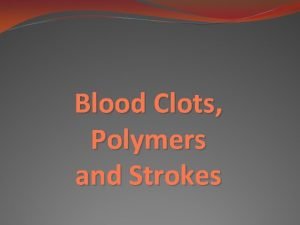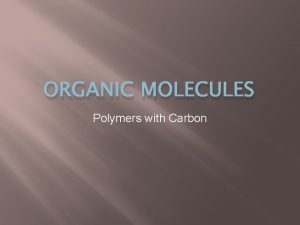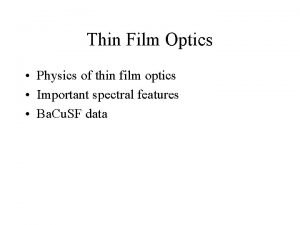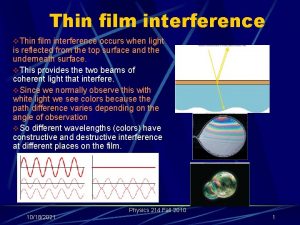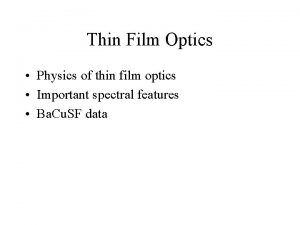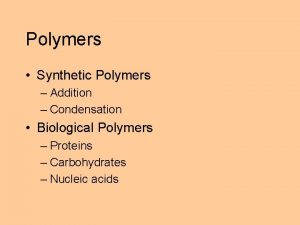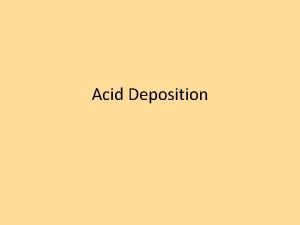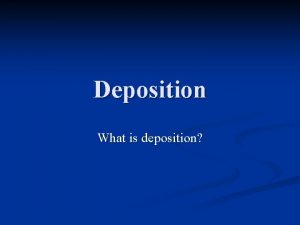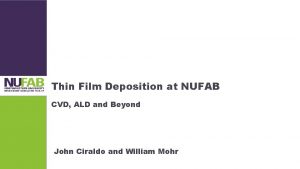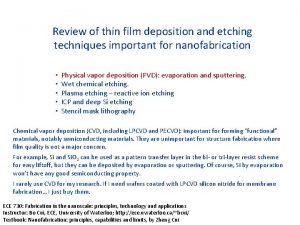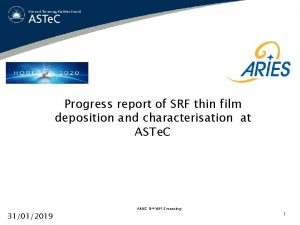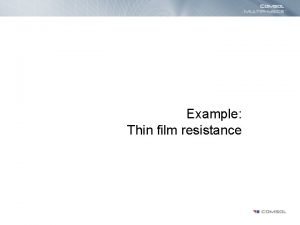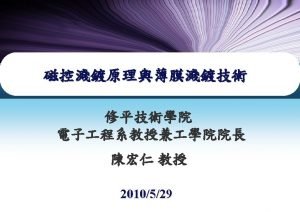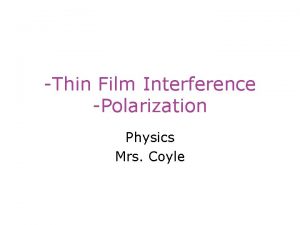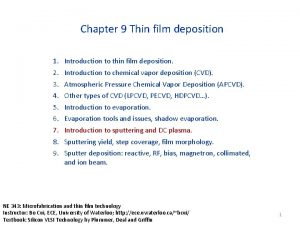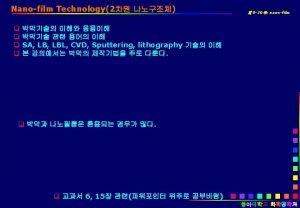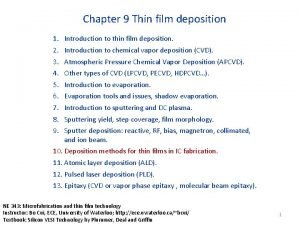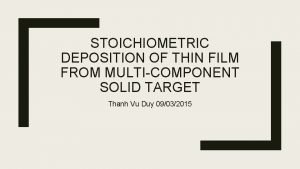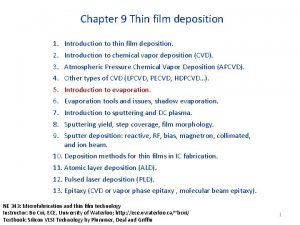Thin film deposition on polymers and deposition of















































- Slides: 47

Thin film deposition on polymers and deposition of polymer thin films sami. franssila@aalto. fi

Sputter deposition of polymers Need RF-sputter, so that there is no charging of the target Deposition rates ~0. 6 nm/s (slightly lower than metals) Hynek Biederman: Organic films prepared by polymer sputtering, JVST A 2000

Self-sputtering of PTFE (CF 2)n Organic films that can be best described as fluorocarbon plasma polymers (Teflon-like) were prepared in the so called self-sputtering mode. In this case argon was used to initiate the discharge that continued to be maintained by the volatile fragments when the argon supply was shut off. RF sputtering of PTFE was also performed in argon. Because sputtered fluorocarbon films were found deficient in fluorine, RF sputtering of PTFE in a CF 4–Ar mixture was used and shown to give stoichiometric films. Hynek Biederman: Organic films prepared by polymer sputtering, JVST A 2000

FTIR-analysis of PTFE film Biederman: J. Vac. Sci. Technol. A 18. 4. , Jul/Aug 2000, p. 1642

XPS-analysis of PTFE-film Biederman: J. Vac. Sci. Technol. A 18. 4. , Jul/Aug 2000, p. 1642

Film structure • These F-rich fluorocarbon plasma polymer films were stable at 450°C for 4 h. • Even after 24 h at 450°C no crystalline structures were observed by x-ray diffraction, i. e. , the films appeared to be amorphous. Biederman: J. Vac. Sci. Technol. A 18. 4. , Jul/Aug 2000, p. 1642

Another PTFE sputter process Thickness @ 30 min ≈ 1000 Å Thickness @ 90 min ≈ 2000 Å If linear deposition rate should be 3000 Å ! Bodas & Gangal: J. Micromech. Microeng. 15 (2005) 1102– 1113 “Negligible increase in thickness beyond a certain time duration may be because of the possible equilibrium established between deposition and etching of the film. ”

XPS analysis of PTFE film Bodas & Gangal: J. Micromech. Microeng. 15 (2005) 1102– 1113

XPS vs. sputtering power Bodas & Gangal: J. Micromech. Microeng. 15 (2005) 1102– 1113

Sputtered Teflon as etch mask Not attacked by hot KOH Has good adhesion to Si Rate Si: rate PTFE = 1 µm/min: 0. 0006 µm/min = 1700: 1 Bodas & Gangal: J. Micromech. Microeng. 15 (2005) 1102– 1113

Film effects on substrate Sputtering (and PECVD and other energetic deposition process) will implant atoms into substrate. Penetration of sputtered film atoms can be 50 nm in polymers. This improves adhesion, which is important since polymers do not readily form bonds with deposited metals or ceramics.

Interphase layer on polycarbonate Plasma effects generally: a) cleaning b) etching c) cross linking d) functionalization (i) plasma pretreatment (cross linked polymer) (ii) mixed polymer-nitride material

(C H ) 14 22 Active channel material in polymer electronics

Evaporator for pentacene

Knudsen cell for pentacene Knudsen cell is an isothermal enclosure with a small orifice (whereas thermal evaporator has open crucible). Vapor emerges in a thermal equilibrium process.

Pentacene TFT process Deposit polyimide Lithography Gold evaporation & lift-off PECVD oxide Lift-off Lithography Pentacene evaporation Lift-off

Flexible TFT: parylene passivation, silicon substrate detachment Feili et al: J. Micromech. Microeng. 16 (2006) 1555– 1561

Evaporation good for lift-off Goettling et al: JOURNAL OF DISPLAY TECHNOLOGY, VOL. 4, NO. 3, SEPTEMBER 2008

Parylene CVD

Jia et al. : Laboratory pentacene and parylene evaporation systems

Parylene CVD: rate up when temperature down ! Not Arrhenius! Jia et al. : Laboratory pentacene and parylene evaporation systems

Rate limiting step This apparent negative activation energy is the signature that surface adsorption of a reactive species is the rate-limiting step. In the adsorption-limited regime, increased substrate temperature reduces adsorption onto the surface, leading to lower deposition rates, but often thickness uniformity is improved.

Sticking coefficient Reactive sticking coefficient (g), is defined as the probability of a precursor species adsorbing/reacting each time it strikes the surface. As g increases, species increasingly stick to the surface on impact, leading to a faster deposition at the trench opening and poor step coverage. Conversely, low values of g lead to multiple collisions before sticking, allowing for deposition deep inside high aspect ratio features.

Parylene step coverage: excellent Monomer first physisorbs and chemisorbs only after overcoming an energy barrier. For the chemisorbed monomer, sticking coefficient was 2. 0*10 -5 at 60 o. C and increased to 1. 4*10 -3 at -60 o. C.

CVD polymer step coverage 300 nm deep trench conformally coated with poly(pxylylene) (parylene) i. CVD poly(tetrafluoro ethylene) (PTFE)

Polymer surface activation • Organic substrates can be chemically activated using a plasma glow discharge. • This activation generates free-radical species on the substrate that can initiate polymerization when contacted with gas-phase polymer precursors. • Alternatively, inorganic substrates can be chemically activated using a piranha solution or oxygen plasma pretreatment to create a high density of surface hydroxyl groups.

PECVD • In PECVD, plasma excitation of the vapor phase creates the radical species. [11] • However, the degree to which organic functionality is preserved often improves by decreasing the plasma power through strategies such as • pulsing the plasma excitation[12– 20] or • performing the deposition downstream of the active plasma region Alf & Gleason article Adv. Mater. 2010, 22, 1993– 2027

Too long and/or high energy pulses destroy polymer functionality Alf & Gleason article Adv. Mater. 2010, 22, 1993– 2027

Hydrogels by PECVD Hydrogel poly(2 -hydroxyethyl methacrylate) (PHEMA) was deposited by pulsed PECVD while preserving the functionality and biocompatibility of the film. Approximately 80% retention of the surface hydroxyl groups, resulting in a sessile drop contact angle of 17 o at a deposition rate of 13. 4 nm/min Alf & Gleason article Adv. Mater. 2010, 22, 1993– 2027

Dangling bonds • if these species are not fully reacted during CVD growth, the resultant polymer film contains so-called dangling bond defects. • Once exposed to the air, these defects can further react with oxygen and water, altering the film properties from their as-deposited state. Alf & Gleason article Adv. Mater. 2010, 22, 1993– 2027

i. CVD (initiator CVD) Alf & Gleason article Adv. Mater. 2010, 22, 1993– 2027

i. CVD reactor Alf & Gleason article Adv. Mater. 2010, 22, 1993– 2027

Alf & Gleason article Adv. Mater. 2010, 22, 1993– 2027

Alf & Gleason article Adv. Mater. 2010, 22, 1993– 2027

PAN nanotubes Anodic Aluminum Oxide (AAO) template Alf & Gleason article Adv. Mater. 2010, 22, 1993– 2027

Rate limiting step i. CVD Filament temperature strongly influences deposition rate. At low filament temperatures, the radical formation from the initiator is the rate-limiting step. At higher filament temperatures, there is a weaker dependence between decomposition rate and filament temperature, suggesting that mass transport of the radical species to the surface becomes the rate-limiting mechanism. Alf & Gleason article Adv. Mater. 2010, 22, 1993– 2027

Organic thin films: wet deposition techniques • • Dip coating Langmuir-Blodgett films layer-by-layer assembly spin coating

Dip coating • Dippings of the substrates (glass, silica wafer etc) into liquid that contains organic molcules or sol-precursors • One dipping: one layer • More dippings: more layers • Two-dimensional nanometer thickness films Ana Isabel Gómez Varela et al: Sol-Gel Glass Coating Synthesis for Different Applications: Active Gradient-Index Materials, Microlens Arrays and Biocompatible Channels, Intech Open 2017

Langmuir-Blodgett: advanced dip coating Amphiphilic molecules organize at water-air interface. Pressure control. Motorized lowering and raising. Hall: The New Chemistry

LB films (2) • To form the film on the water surface, the molecules need to be surface active, i. e. they have both hydrophobic and hydropilic parts • For example hydrophobic polymers to have hydrophilic side chains etc. Hydrophobic backbone Hydrophilic sidechains d Kontturi et al

Langmuir-Blodgett through • Langmuir-Blodgett technique is based on formation of ”floating” film on water, its compaction by ”squeezing” to make densified 2 -dimensional solid-like film on water surface, and its transfer on a substrate d Kontturi et al

LB: Pressurization curve Multiple layers Hall: The New Chemistry

Polyelectrolytes/Layer-by-layer These films are random, while LB films are highly organized. Matsusaki et al: Adv. Mater. 2012, DOI: 10. 1002/adma. 201103698

Polyelectrolytes (Lb. L 2) Matsusaki et al: Adv. Mater. 2012, DOI: 10. 1002/adma. 201103698

Spin coating Film thickness is largely a balance between the force applied to shear the fluid towards the edge of the substrate and the drying rate which affects the solids content and thus viscosity. As the film dries, the viscosity increases until the radial force of the spin process can no longer appreciably move the liquid over the surface. Franssila: Introduction to Microfabrication

Thickness in spin coating The two main factors affecting film thickness are: • viscosity η (which depends on solid content and solvent) • spinning speed ω (faster thinner) Spin speed can be used to tailor thickness over one decade, e. g. 0. 5 -5 µm, but beyond that a new formulation with different viscosity must be used. Viscosity is dependent on solid content (which can vary from 2080%) and temperature. Solvent evaporation rate depends on ambient environment, and a closed spinner bowl with saturated solvent vapor and adjustable exhaust from spinner bowl can both be used to control evaporation.

Spin coating pros and cons -short coating time (< 1 min) -reliable -cheap -uniform film thickness in case of Newtonian liquids (=viscosity remains constant with shear rate) -Various film thicknesses possible (0. 1 µm to 500 µm) -always requires baking step afterwards Particles can become “sources” of defects: liquid does not spread evenly behind an obstacle. Topography on surface nonuniform film thickness because liquid-like resist partly conforms and partly tries to flatten out.
 Thin film deposition
Thin film deposition Define coated tablet
Define coated tablet Parasite in blood smear
Parasite in blood smear Thin and thick film integrated circuit
Thin and thick film integrated circuit Thin film characterization techniques
Thin film characterization techniques Interference in thin film
Interference in thin film What is thin film in physics
What is thin film in physics Interference in thin film
Interference in thin film Fiber texture pole figure
Fiber texture pole figure Thin film formula
Thin film formula Pvc membrane film
Pvc membrane film What is thin film
What is thin film Thin film interference
Thin film interference Sugar-coated tablets examples
Sugar-coated tablets examples Thin film interference
Thin film interference Slipper or guide bearing
Slipper or guide bearing Application and processing of polymers
Application and processing of polymers Addition polymers 2 chemsheets answers
Addition polymers 2 chemsheets answers X mold polymers
X mold polymers Water soluble antiscalant polymers
Water soluble antiscalant polymers Polystyrene monomer
Polystyrene monomer Thermosoftening plastics examples
Thermosoftening plastics examples Meros polymers
Meros polymers Polymers product design
Polymers product design Polymer in dentistry
Polymer in dentistry Homochain polymers
Homochain polymers Osmometry molecular weight determination
Osmometry molecular weight determination Factors affecting crystallinity in polymers
Factors affecting crystallinity in polymers Types of commodity plastics
Types of commodity plastics Structure of polymers
Structure of polymers Homochain polymers
Homochain polymers Polymers advantages
Polymers advantages Polymers physical properties
Polymers physical properties Polymers of sugar
Polymers of sugar Inorganic polymer
Inorganic polymer Chemsheets
Chemsheets Synthetic organic polymers
Synthetic organic polymers Nylon demo
Nylon demo Biological polymers examples
Biological polymers examples What does mono mean
What does mono mean Designer polymers
Designer polymers Z-polymers
Z-polymers Color coding of sutures
Color coding of sutures Natural polymers
Natural polymers Rubber elasticity definition
Rubber elasticity definition Big six polymers
Big six polymers Addition silicone byproduct
Addition silicone byproduct Characteristics of polymers
Characteristics of polymers
